![]()
1 December 1944
| 31 December 1944 | 1
February 1945 | 4 March 1945 | 3
April 1945
2 May 1945 | 28 May
1945 | 5 June 1945
--------------------------------------------------------------------------------------------------
McCabe's
letters home, 1944-46 | Larry
Lemberg's McCabe Recollections | Rosswalden,
April 20, 1945, photo & notes |
McCabe's Memo to 419th AFA Bn.,
Jan.9, 1945
| McCabe's VE day photos, May 9, 1945
---------------------------------------------------------------------------------------------------
419th Field Artillery Battalion
10th Armored Division
Total Strength ----- 518
Killed in action --- 8
Wounded in action -- 44
Missing in action -- 1
Decorations (record incomplete)
Presidential Unit Citation -- 1
Killed in action -------------- 3144
Wounded in action ---------- Unknown
Prisoners captured ------------- 931
Vehicles and tanks destroyed --- 118
Command Posts destroyed ---------- 3
Observation Posts destroyed ------ 4
Artillery Pieces destroyed ------ 52
Anti-tank guns destroyed -------- 27
Mortars destroyed --------------- 18
Machine guns destroyed ---------- 31
Assault boats sunk --------------- 4
Railway trains destroyed --------- 1
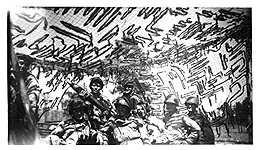
Battery "A" Commander, Capt. Anderson (left), Battery Exec. Lt. Gebhardt, Chief of 1st Gun Section Sgt. Regovich and crew (guy holding shell used to pitch for Brooklyn Dodgers). Taken next to M-7 in position under camauflage net.
—Lt. Gebhardt's handwritten notes from photo back
419TH ARMORED FIELD ARTILLERY BATTALION
APO 260, U.S. ARMY
1 December 1944
Subject: After Action Report, 419th Armd FA Bn.
TO: Commanding General, 10th Armd Div., APO 260, US Army.
- Personnel
- a. Total effective strength:
(1) Beginning of period: 32 Officers, 2 WO, 484 EM.
(2) End of period: 33 Officers, 2WO, 491 EM.- b. Casualties during action.
(1) Killed: None
(2) Wounded: 2 Officers & 9 EM
(3) Missing: None
Replacements received: 3 Officers and 13 EM- Enemy
- a. Identification of enemy
(1) 2-7 Nov 44, 416th Inf. Div., and 462 Inf. Div., 19th Grenadier Div., and 17th SS Div.
(2) 8-12 Nov 44, 1st Co. 35th Grenadier (Panzer) regmt, 1st Bn. 712th regmt (Inf), and 25th Grenadier (Panzer) Div.
(3) 13-15 Nov. 44, 1st Co. 35th Grenadier (Panzer) regmt, 1st Bn. 712th rgmt (Inf), 419th Div (Inf), and 25th Grenadier (Panzer) Div.
(4) 16-30 Nov. 44, 456t & 457th GHO Arty Battalions, 712th, 713rd, and 714th Inf. regmts., 3d Co. 220th Armd Engr Bn, 2d Co. 74th Inf. Regmt., 1st Alarm Co. 21st Panzer Div., 1st Co. 416th Signal Bn. (of 416th Inf. Div.), and 1st Co. 306th Festungs Pionier Bn. Hq Co, 486th Panzer-Zerstdrungs Bn., and 1st Btry, 404th Volks Artillery Corps.- b. Summary of enemy operations: During 2-5 November 44 enemy patrols active plus artillery fire from forts; Driant and Geanne D'Arc. 12 Nov. 44 enemy shelled the bridge across Moselle River at Malling, France. 16-17 Nov. 44 enemy fought dealying action with heavy artillery fire, and slowly retreated thru Bibiche, Monnern, and Obernauman, France. 18-30 Nov. 44 Enemy maintained active defense along entire front, and observed firing rocket type projectiles.
- c. Enemy losses: Unknown.
- Own Operations
- a. 1-7 Nov. - Relieved 344th FA Bn. West of Metz. Supported 20th Armd Inf. Bn. until it was relieved by 61st Armd Inf. Bn. until it was relieved by 61st Armd Inf. Bn. Fires consisted mainly of harassing fires. Bn was reinforced by a medium tank company form 3rd Armd Tank Bn, and five platoons of 705th TD Bn all using indirect fire.
8-14 Nov.--Occupied position near Burmerange, Luxembourg as corps artillery. Supported attack of 90th Inf. Div., which was making bridgehead across the Moselle River in vicinity of Malling.
15-19 Nov.--Supported attack of Team Standish with bridge across Neider River east of Freistroff as objective. Objective secured. Team Chamberlain was on our left flank and the 95th Inf. Div. was on our right.
20-30 Nov.--Supported Team Standish from the vicinity of Behndorf, Germany in attack on Siegfried Line in vicinity of Tettingen, Germany. Supported Team Riley in active defense of sector.- b. Team Riley in reserve until Nov. 25th when Team Riley took over sector from Team Standish.
- c. 1 Nov.--Moving to front.
2 Nov.--Relieved 344th FA Bn East of Vionville, France.
3-6 Nov.--Supported 20th Armd Inf Bn & 61st ArmdInf Bn in front of Metz. Mainly harassing and interdiction fires.
7 Nov.--Moved 80 miles blackout to Burmerange to act as corps artillery in supporting 90th Inf. Div. who were to secure a bridgehead across Moselle River.
8 Nov.--Bn supported attack of 90th Inf. Div. Fired Reinforcing fires.
9 Nov.--Continued to fire as corps artillery. Fwd. obs. sent across river with 90th Inf Div and was wounded. S/Sgt. Shaibley recommended for Bronze Star and Pfc Danko for Silver Star.
10 Nov.--Reinforcing fires of 90th Inf. Div.
11 Nov.--Bn. moved to positions around Fixem, France in order to reach further beyond the bridgehead and also to be ready to cross the Moselle River.
12 Nov.--Acted as corps artillery.
13 Nov.--Acted as corps artillery.
14 Nov.--Acted as corps artillery.
15 Nov.--Joined Team Standish and moved across the Moselle. Objective: Bouzonville. Advance guard battery committed at 1500 hours, and remainder of battalion moved into position near advance guard battery. Fired on enemy infantry and AT guns holding up attack. Advance guard halted in Lemenstroff.
16 Nov.--Advance party advanced to St. Marguerite over almost impassible roads, after first taking the wrong road and seizing Budling. Artillery support was very effective in first a preparation on St. Marguerite. Bn displaced to position West of Lemenstroff. Capt. Kreigsman recommended for Bronze Star.
17 Nov.--Objective changed--to secure bridge across Neider River east of Freisthoff. Advance party secured Dalstein. Advance guard battery displaced to Menneren. Bn fired in supporting tank attack near Dalstein.
18 Nov.--Advance guard reached Freisthoff. Bn displaced to vicinity of Dalstein. Fired at AT guns and infantry holding up advance.
19 Nov.--Advance held up by heavy fire from high ground east of Freistroff. Bridge in our hands. Bn displaced to position 1 mile west of Freistroff and fired on enemy installations across river.
20 Nov.--Moved to Sehndorf with objective of moving on Saarburg. Supported attack on Nenning and Tettingen. Strong enemy opposition. Fired on enemy infantry, OP's, AT guns, and artillery positions.- d.
21 Nov.--Continued to support the attack.
22 Nov.--Bn reinforced fires of 344th FA Bn.
23 Nov.--Bn reinforced fires of 344th FA Bn. Lt. Carter and Lt. Dietrich each recommended for Silver Star.
24 Nov.--Bn reinforced fires of 344th FA Bn.
25 Nov.--Bn in direct support of Team Riley which has taken over sectors with mission of active defense. Fired on enemy infantry, mortars, and AT guns.
26 Nov.--Continued support of Team Riley.
27 Nov.--Continued support of Team Riley.
28 Nov.--Continued support of Team Riley.
29 Nov.--Moved to position near Betting, France. Support attack of CC B, to seize high ground West of Mervig.
30 Nov.--Bn in direct support of Team Standish, which had the mission of clearing the southern half of the woods which lie between Wellingen and Schwemlingen. Mission was accomplished expeditiously.- Supply and Evacuation
Existing procedures and installations functioned satisfactorily.
Recommendations: None. - a. Total effective strength:
- Personnel:
- a. Total effective strength
(1) Beginning of period: 33 Officers, 2 WO, & 421 EM
(2) End of period; 33 Officers, 2 WO, & 485 EM- b.Casualties during action
(1) Killed: None
(2) Wounded: 1 EM
(3) Missing: None- c. Replacements received: 4 EM
- Enemy:
- a. Identification of enemy
(1) 1-18 Dec. 44: 19th Inf. Div., 404th Volks Artillerie Corps (1st Btry), 719th Artillerie Regmt., and 130th Pz. Lehr. Div.
(2) 18-24 Dec. 44: 212 Volks Gernadier Div., 44th Fortress MG BN., 978th Inf. Regmt., 276 Volks Grenadier Div., 12th SS Panzer Div., 130th Panzer Lehr Div., and 987th & 988th WF Regiment.
(3) 24-27 Dec. 44: 986th WF Regmt., 276 Fusilier Co., 987th Inf. Regmt., and 252nd Volks Grenadier Div.
(4) 27-31 Dec. 44: No units in contact.- b. Summary of enemy activities
(1) 1-18 Dec. 44: Enemy activity limited to small night patrols and harassing artillery fire. Patrols cut communication lines and laid mines in rear areas. Our observers in Hilbringen were fired on constantly by machine guns in pillboxes on east bank of Saar River.
(2) 18-24 Dec. 44: Enemy counterattacked in strength, crossing Sure River at Echternach, supported by heavy concentrations of artillery and Nebelwerfer fire from east of Sure River. G-2 reports of enemy forces wearing United States Army uniforms and using U.S. weapons were born out of reports of Sgt. Stern of "A" Company who stated that he personally killed a German private at Hill 313 northeast of Echternach, who was wearing an American uniform and carrying an M-3 Sub-Machine Gun.- b.(2)Anti-tank activity limited to Bazooka and Panzer Faust fire. Enemy morale highest yet encountered, and their troops were very aggressive.
(3) 24-27 Dec. 44: Enemy activity confined to delaying action as his troops withdrew to east of Sure River. However, his Nebelwerfer fire was the heaviest yet encountered and was very effective.
(4) 27-31 Dec. 44: Not in contact with any enemy units.- c.Enemy losses: Unknown except for 350 enemy dead, killed by artillery fire near Fern Michalshoff. Reported by Company Commander, Company "A", 169th Engineer Battalion.
- Our operations:
1 Dec. 44--Battalion remained in position reinforcing the fire of the 695th Armd. FA Bn., and fired on enemy troops as they were driven across the Saar River.
2 Dec. 44--Battalion displaced to vicinity of Silwingen, Germany in order to be able to employ time fire east of the Saar River. An observation post was established in Hilbringen, Germany, and also one about 200 yards northeast of Silwingen. The zones of observation from both OP's combined covered the entire sector. Continued to reinforce the first of the 695th Armd FA Bn.
3 Dec. 44--Battalion continued to reinforce the 695th Armd FA Bn. Two M-7's per battery plus two half tracks per battery were kept at the Command Post in Betting, France in order to insure by a rotation system that 2/3 of each battery remained in position while 1/3 were T.I., and the personnel given a chance to wash clothing and get a bath.
4 Dec. 44--Continued to reinforce the 695th Armd FA Bn.
5 Dec. 44--Continued to reinforce the 695th Armd FA Bn. One round of counterbattery 105mm landed in "A" battery position at 1700 hours. One man wounded by a fragment.
6 Dec. 44--Continued to reinforce the 695th Armd FA Bn.
7 Dec. 44--Continued to reinforce the 695th Armd FA Bn.
8 Dec. 44--Continued to reinforce the 695th Armd FA Bn.
9 Dec. 44--Continued to reinforce the 695th Armd FA Bn. A formation was held at Hq, A & C battery positions to present decorations. In a martial setting with the batteries firing on targets east of the Saar and with an air corps bombardment of Merzig, Germany the following awards were made: The Silver Star--Lt. Henry G. Carter. The Soldier's Medal--Capt. Gerald J. Murray and S/Sgt Robert S. Tellalisn. The Bronze Star--Capt. Albert O. Kreigsman, S/Sgt. William R. Kneebone, and Pfc Mark T. Welch.
10 Dec. 44--Continued to reinforce the 695th Armd FA Bn.
11 Dec. 44--Continued to reinforce the 695th Armd FA Bn.
12 Dec. 44--Continued to reinforce the 695th Armd FA Bn.
13 Dec. 44--Continued to reinforce the 695th Armd FA Bn.
14 Dec. 44--Officers school on "Battlefield Experiences", held at 1500 hours at Battalion Fire Direction Center. Recommendations submitted to Division Artillery.
15 Dec. 44--Continued to reinforce the 695th Armd FA Bn.
16 Dec. 44--Battalion alerted at 2130 hours to be ready to move at daylight. Destination and route unknown.
17 Dec. 44--Battalion moved out at 0730, meshed into CC B column, and marched to Steinsel, Luxembourg a distance of 43 miles. Upon arrival at Steinsel the Battalion reverted to Division Artillery control.
18 Dec. 44--The Battalion was alerted at 0100 to be prepared to support an attack at 0800 on Echternach, Luxembourg by Task Riley. Liaison Officer had trouble locating Col. Riley's Command Post to get initial point, route, and plan of attack so Battalion moved 25 miles to the vicinity of Altrier, Luxembourg, and went into position in front of the attacking force. Battalion supported the attack which was successful. Battalion displaced forward 3000 yards at 1500 in order to reach the river with time fire.
19 Dec. 44--American troops withdrew west as Germans continued to expand their bridgehead north of Echternach. Strong forces of enemy infantry and armored vehicles were reported filling the bridgehead. Battalion remained in position supporting Task Force Riley as it withdrew west.
20 Dec. 44--Battalion continued in support of Task Force Riley, and also took over support of Task Force Standish when 423rd FA Bn was withdrawn to another sector. When both task forces were withdrawn at dusk the 419th Armd FA Bn. remained in position to reinforce the 4th Division Artillery. Investigation of the front revealed that oue sector was defended by the 2nd Battalion 12th Infantry, the 159th Combat Engineer Battalion, and 4th Division Engineers, and of this force, only the 2nd Battalion 12 Infantry had artillery support. The 419th Armd FA Bn, immediately sent Liaison Officers and Observers to both engineer units and a liaison officer to the 2nd Battalion 12th Infantry Regiment. The situation was precarious with gaps between companies and with absolutely no contact with units to the right. Artillery support was urgently needed with enemy attacks coming constantly along the entire sector and the 419th Armd FA Bn. was firing almost constantly, beating back one attack after another. Reports from the left sector revealed and the 419th Armd FA Bn. would be cut off to the rear. Reports from the right part of the sector revealed that enemy infantry were infiltrating through our lines and that there was a one mile gap on our right flank 1500 yards from the Battalion position. Battalion Commander and Battalion S-2 went forward to attempt to determine the dispositions of units ahead and to our right, but were pinned down by enemy machine gun fire from the right and had to withdraw. There were obviously no friendly troops to our right and the Germans knew it. The Battalion was in imminent danger of either attacks from front and flanks or of being cut off to the rear by enemy action. So urgent and constant were the calls for artillery that the Battalion could not lose 1/3 of its fire power by displacing to the rear by battery. The decision to remain in position was made and all batteries were alerted for direct fire against ground attack. All avenues of approach were blocked by mine necklaces and bazooka teams and the attached anti-aircraft protection and mesh into the perimeter defense of the Battalion for defense against ground attack. During the night the 419th Armd FA Bn. swept the one mile gap to our right with harassing fire and no Germans penetrated through. Three hundred fifty (350) enemy dead from the fire of the 419th armd FA Bn. were counted in one ravine later by Company "A" 159th Engineers. The Germans were marching up the ravine in the approach march prior to deploying when a 419th Observer heard them and cut them to pieces with artillery fire. Battalion fired 2952 rounds n less than 24 hours. Most of this was on observed missions with excellent effect.
21 Dec. 44--Upon being informed that the 159th Engineers were withdrawing slightly in order to reorganize, it was found that the new main line of resistance in this part of the sector was so close to the Battalion that it could not use indirect fire to support it. During a temporary lull in attacks the sector could be constantly covered even though the leading battery might be masked. The Battalion was covering a 1800-2000 square mil front. The Battalion fired almost constantly throughout the day repelling attack after attack with heavy losses. During the day one Forward Observer Team with the 159th Engineers was cut off, but worked back through to American lines that night. The tank was ordered back in time to save it from German Bazooka teams. Late in the afternoon the Germans apparently abandoned their attacks and went on the defensive. Calls for artillery became less frequent and the artillery began harassing fires on probable or reported assembly areas or routes of approach.
22 Dec. 44--The dangerous situation on our right flank was relieved by the arrival of the 10th Combat Team, 5th Infantry Division. The 419th Armd FA Bn. immediately established liaison with the direct support artillery battalion of this combat team and fired several missions for them.
23 Dec. 44--Sector was rather quiet. Fired several missions for the 10th Combat Team as they attacked toward Echternach. Fair visibility so plane was ordered up to search for enemy bridges across the river. Located one and we began adjusting on it with a 155 mm gun. Pilot went into fire for effect but was driven away by anti-aircraft fire. Results of adjustment are unknown. Battalion moved out 1700, and marched to Nommern, Luxembourg. There it reinforced the fires of the 695th Armd FA Bn. A later check-up of the 419th Armd FA Bn. sector near Echternach by the 4th Division revealed more than 2000 dead Germans, most of them killed by artillery fire. The number wounded is unknown, but it is probably much more than the dead. Since the 419th Armd FA Bn. fired practically all the missions in this sector it is believed that most of the Germans killed and wounded can be credited to the Battalion. The Battalion expanded 6232 rounds in this sector with most of it fired on observed targets. At one time this Battalion had out twelve (12) observers and liaison officers.
24 Dec. 44--Battalion displaced east of Stegen in afternoon in order to reach river with time fire.
25 Dec. 44--Battalion still reinforcing the fires of the 695th Armd FA Bn.
Battalion enjoyed excellent Christmas rations, which included fresh eggs and ham for breakfast, and turkey for dinner.
During the night of 25-26 December, the Battalion fired its first rounds using the Pozit Fuze. The sector was relatively quiet all day.
26 Dec. 44--During the morning, arrangements were made for the relief of the Battalion by the 128th Armd FA Bn. of the 6th Armored Division. Late in the afternoon, the firing batteries of that Battalion took over the positions of this Battalion, one battery at a time. Our batteries displaced to near-by assembly areas.
At 2045 hours, the Battalion began its march to Heisdorf, Luxembourg, and vicinity; the tail closed in at 2345 hours. Purpose was to put the Battalion within convenient distance of the Initial Point in Dommeldange at which it had been directed to join the column of CC R.
27 Dec. 44--Battalion marched at 0715 hours and closed into its assigned area in Metz at 1630 hours. The march was uneventful except for difficulties encountered on a steep, icy stretch of road between Echternach and Angevillers. The steel tracks of our M-7s slid like skates on an ice rink. While the leading howitzer battery, (Battery A), tediously worked its way foot by foot up the icy road by putting dirt, rocks, logs, pieces of wire fence, etc. under the tracks to make them hold, reconnaissance for a better road was instituted by the Battalion Commander. By re-routing batteries B and C and the steel-track vehicles of Service Battery over a much better road which was found, the head of the diverted column reached the junction point in Fontoy almost the same time as the head of the other column so that a smooth junction was effected.
Personnel are established in a group of buildings which at various times must have comprised excellent quarters for their French and German garrisons. Our vehicles are well dispersed in adjoining fields.
28 Dec. 44--Battalion started at once in an intensive schedule of vehicular maintenance, clothing and equipment inventories and inspections, and police the area. The building and surroundings had been left in filthy condition by the former occupants.
29 Dec. 44--Program of the 28th continued today.
30 Dec. 44--Saturday morning inspection found men, vehicles, equipment and the area to be in very good condition. It is little short of amazing how the battalion personnel have succeeded in cleaning up the occupied building and area.
The Division G-4, Lt. Col. Weber, accompanied the Battalion Commander in his inspection. He gave particular attention to the condition of the clothing and equipment, and appeared well satisfied with what he found.
Major Averett, the Division Sanitary Inspector, made an inspection in company of 1st Lt. Waldrep, the Battalion Surgeon. He, too, was very pleased with what he found.
31 Dec. 44--Catholic services at 1100 hours. Protestant services at 1400 hours. Recreation schedule includes movies in the afternoon and evening. Vehicular maintenance continues.- Supply and evacuation-existing procedures and installations functioned satisfactorily.
- Recommendations-None.
- a. Total effective strength
- Personnel
- a. Total effective strength:
(1) Beginning of period: 33 Officers, 2 WO, 485 EM.
(2) End of period: 33 Officers, 2WO, 488 EM.- b. Casualties during action.
(1) Killed: None
(2) Wounded: None
(3) Missing: None
Replacements received: 7 EM- Enemy
- a. Identification of enemy:
(1) 1-17 Jan. 45: The 419th FA Bn. was at Metz, France in rest camp. Not in contact with the enemy.
(2) 17-18 Jan. 45: The 419th FA Bn. bivouaced in Donnelay, France. Not in contact with enemy units.
(3) 18-31 Jan. 45: Elements of the 314th Inf. Div. Kampf Gruppe Wagner.- b. Summary of enemy activities
(1) 1-17 Jan. 45: 419th FA Bn. was at rest camp in Metz. Not in contact with enemy.
(2) 17-18 Jan. 45: 419th FA Bn. in bivouac at Donnellay, France overnight. Not in contact with enemy.
(3) 18-31 Jan. 45: The 419th FA Bn. moved into firing position in Merlebach, France. Enemy activity in the 419th FA Bn. sector was very limited. Spasmodic exchange of 419th Armd FA Bn sector was very limited. The enemy managed to drop some mortar fire around the O.P.'s. Some high velocity 50mm gun fire fell on "A" Battery's O.P. Enemy patrols were active up to and including 29 January 1945.- c. Enemy losses: Number of enemy killed unknown.
- Our operations:
1-16 January 45:--Battalion remained in Metz, France. All vehicles, weapons and equipment were thoroughly inspected; necessary repairs were made and relacements were obtained. Steel tracks were removed from the M-7's, and replaced by rubber tracks. A battalion drill schedule was prepared and followed, in keeping with Division and Division Artillery directives.
The usual routine was relieved on the 13 Jan 45 by a ceremony and presentation of awards. At 1130 hours the entire battalion formed in the quadrangle, in line of batteries, with batteries in mass formation. Col. Luebbermann, Division Artillery Commander, formally presented the Battalion Standard to the Battalion Commander, Lt. Col. Robert C. McCabe.
Following the presentation of the Standard, Col. McCabe presented the following awards to personnel of this organization:
(1) Pfc Michael J. Danko, 36 540 839, was awarded the Silver Star
(2) 2d Lt. John R. Fray, 0 467 185, was awarded the Silver Star
(3) Major James M. Hutchinson, 0 284 563, was awarded the Bronze Star
(4) Major Arthur C. Ball, 0 328 166, was awarded the Bronze Star
(5) Capt. Roger M. Keefe, 0 414 613, was awarded the Bronze Star
(6) Capt. David Anderson, 0 438 577, was awarded the Bronze Star
(7) Capt. Sewell H. Corkran, 01 166 693, was awarded the Bronze Star
(8) 1st Lt. Joseph T. Gebhardt, 01 178 160, was awarded the Bronze Star
(9) Pfc Kenneth N. Manning, 18 193 570, was awarded the Bronze Star
During the ceremony, music was furnished by the 10th Armd Div. Band. After the awards were presented, the battalion passed in review before Col. McCabe, his staff and the persons who had just been decorated. The entire ceremony was smoothly executed and very impressive, despite the fact that marching was made difficult by snow and ice.
17 Jan. 45:--Battalion marched in convoy to Donnelay, France.
18 Jan. 45:--Battalion left Donnelay at 1330 and marched to Merlebach, France, where it went into firing positions. Our mission, pending the arrival of the 342d Armd FA Bn., was direct support of the 106th Cavalry Group, which comprised the 106th and 121st Cavalry Squadrons.
19-31 Jan. 45:--Situation was defensive. There was very little activity in the sector. As part of our preparations for a possible enemy attack, "B" Battery displaced on 24 January to a position just South of Merlebach, and "C" Battery displaced on 25 January to a position in the vicinity of Bettingen, France. By this maneuver, the batteries were echeloned in depth to the rear in such fashion that, if necessary, they could leap frog to other positions one-at-a-time; the battalion was able to support the existing front, and was in excellent position to support the line which had been selected as the new front to be formed by our troops in the event they were forced to give ground.
By 25 January, the 342d Armored Field Artillery Battalion was ready to take over its mission of direct support of the 106th Cavalry Group. The 419th reverted to a general support role, reinforcing the fires of the 342d. However, since the 342d was not in position from which it could adequately support the whole front, it was agreed that the 419th would continue to provide direct support to the 121st Cavalry Squadron.
Consequently, the 419th continued to man and operate two static Observation Posts, and to keep a liaison officer and section at the headquarters of the 121st Cavalry Squadron as well as the headquarters of the 342d Armd FA Bn.
In preparation for possible employment of the battalion in support of the CC A, the battalion on 29 January sent a liaison officer and section Headquarters CC A, and one RO section and one FO section to Team Richardson, which was part of CC A. Two FO sections remained with Team Standish, which was still stationed in Merebach.- Supply & evacuation: Existing procedures and installations functioned satisfactorily.
- Recommendations: None.
- a. Total effective strength:
- Personnel
- a. Total effective strength:
(1) Beginning of period: 33 Officers, 2 Warrant Officers, 488 Enlisted Men.
(2) End of period: 33 Officers, 2 Warrant Officers, 475 Enlisted Men.- b. Casualties during action.
(1) Killed: One (1) Enlisted Man
(2) Wounded: One (1) Officers - Ten (10) Enlisted Men
(3) Missing: None
Reinforcement received: One (1) Officer and One (1) EM- Enemy
- a. Identification of enemy
(1) 1-10 Feb. 45, The 419th Armd FA Bn. was at Merlebach, Germany. The 419th Armd FA Bn. was in contact with the enemy during the period in a holding position. Units in contact: 347th Inf. Div. V.G., Kampf Gruppe Wagner Bn., 861st V.G. Regiment, Alarm Co. 347th Bn.
(2) 10-19 Feb. 45, The 419th Armd FA Bn. was at Metz, France as S.H.A.E.F. Reserve. Not in contact with enemy.
(3) 19-20 Feb. 45, The 419th Armd FA Bn. was at Borg, Germany. Units in contact with: Remnants of 256th V.G. Div., 416th Inf. Div., 523d G Hq. Eng. Bn.
(4) 20-21 Feb. 45, The 419th Armd FA Bn. was at Merzkirchen, Germany. Units in contact with: Same as period of 19-20 Feb. 45.
(5) 21-26 Feb. 45, The 419th Armd FA Bn. was at Onsdorf, Germany. Units in contact with: 1st Co. 256th Eng. Bn., Fusilier Co., 456th Regt., Hq Co 481st Inf. Regt., 1st 3d, 4th, 6th, 8th & 13th Co's of the 481st Inf. Regt. All Co's were components of the 256th Volks Grenedier Div.
(6) 26-27 Feb. 45, The 419th Armd FA Bn. was in position at Irsch, Germany. Units in contact with same as period of 21-26 Feb. 45.
(7) 27-28 Feb. 45, The 419th Armd FA Bn. went into firing position at Steinbach, Germany. The Bn. fired on enemy tanks and personnel in open and possible rocket positions. Enemy in contact with: Same as period 21-26 Feb. 45.- Enemy
- b. Summary of Enemy Activities:
(1) 1-10 Feb. 45, The 419th Armd FA Bn. still in position at Merlebach, Germany which it occupied on the 18th of January 45. Continued to fire on observed enemy targets such as OP's, machin gun positions, train carrying coal and possible enemy small arms factory in Forbach, which was enemy held.
(2) 10-19 Feb. 45, The 419th Armd FA Bn. was at Metz, France as S.H.A.E.F. Reserve. Not in contact with enemy.
(3) 19-20 Feb. 45, The 419th Armd FA Bn. was at Borg, Germany. Fired on anti-tank guns and enemy vehicles.
(4) 20-21 Feb. 45, The 419th Armd FA Bn. was in firing position at Merzkirchen, Germany. Enemy rounds from artillery fell in our position. The Bn continuing its support of our attacking tanks fired on enemy battery positions, enemy infantry in the open and enemy vehicles.
(5) 21-26 Feb. 45, The 419th Armd FA Bn. was at Onsdorf, Germany. The Bn continued its support of CC A's attacking columns firing on enemy tanks, enemy towns, enemy in woods, enemy artillery positions and enemy in boats in the Saar River.
(6) 26-27 Feb. 45, The 419th Armd FA Bn. was in position at Irsch, Germany. It fired on enemy foritifed positions, enemy tanks and vehicles and enemy infantry in open.
(7) 27-28 Feb. 45, The 419th Armd FA Bn went into firing position at Steinbach, Germany. The Bn. continued its vigorous support of CC A's attacking columns firing on enemy vehicles, enemy rocket positions, enemy artillery battery positions, enemy infantry in open and enemy OP's.- c. Enemy losses:
(1) Killed - 355
(2) Vehicles destroyed - 7
(3) CP's neutralized - 3
(4) OP's neutralized - 4
(5) Field Pieces destroyed - 14
(6) AT guns neutralized or destroyed - 20
(7) Machine guns destroyed - 20
(8) Mortars neutralized or destroyed - 6
(9) Railroad car destroyed - 1
(10) Assault boats destroyed - 4
(11) Prisoners captured - 68- Our operations:
1-9 Feb. 45: Battalion remined in position in the Merlebach area. Our supported units maintained their defensive roles throughout this period. The sector was quiet. On 9 Feb. the Bn. Comdr. made the following presentations of awards:- Pfc Earl B. Dougherty, 6 955 813, Btry C. 419th - Air Medal
- 2d Lt. Bernard M. Winsberg, 01 178 392 - Air Medal
- 1st Lt. James R. Chappell, 01 182 392 - Air Medal
- Tec 5 Andrew Nastasi, 33 399 987 - Hq Btry, Bronze Star
- Pfc William D. Lewis, 6 134 586 - Bronze Star
- 2d Lt. Marion C. Dietrich Jr., 0 535 597 - Bronze Star
- Sgt. Bernard O. Langston, 6 397 627 - Bronze Star
- Cpl Harold S. Lorah, 33 371 461 - Bronze Star
10-18 Feb. 45:On 10 Feb., the Bn. was released from its mission in the Merlebach area and was ordered back to Metz. The march was uneventful. The bn. returned to the saem area that it had vacated 17 Jan. After thoroughly cleaning and policing the area, and after performing necessary maintenance on vehicles and equipment, the bn. entered upon a regular garrison training schedule, closely supervised by the bn. Comdr. and Staff, by the Div. Arty Comdr and Staff, and by representatives from Div. Hqs.
19-24 Feb. 45:During this period the battalion was in direct support of CC A in the operation whcih drove the Germans out of "The Triangle"--the roughly triangular area between the Moselle and Saar Rivers, with its apex at the confluence of the two rivers.
One lesson learned during this attack is that when a dtermined tank force attacks constantly against comparatively light resistance, and when it by-passes towns or roles through them without stopping to mop up, the tank force can outstrip its artillery and pass beyond supporting artillery range. This situation developed on 20 February, when Task Force Chamberlain made its non-stop drive to its final objective. The gap was closed by displacing the 419th (A) FA Bn forward behind Team Holehouse, which comprised the reserve of Task Force Chamberlain and whose mission was to mop-up the towns in the wake of the advance elements of the task force.
On the morning of 21 Feb., the 419th (A) FA Bn. had the unique experience of being attacked by a friendly force. The Bn. had spent the night with its CP in the town of Merzkirchen and with the howitzer batteries in firing positions in fields adjacent to the town. About 0800 hours, things began to happen. Snipers in a church steeple fired at our men in the streets; the positions of "A" and "C" batteries from over a crest to the east. Prompt and overwhelming fire from our attached AAA weapons and individual small arms weapons quickly silenced the snipers. "A" and "C" batteries displaced immediately to alternate positions which afforded sight defilade.
The pilot of a field artillery liaison plane, by several times flying almost at ground level between the attacking forces and the town, succeeded in conveying to the people on the ground the ground that something was amiss. Investigation disclosed that the attacking force was Team Billet, composed of tanks and infantry frm Task Force Richardson. Our little "war" was called off, fortunately before either side had done damage to the other.
25-28 Feb. 45:On 25 February the 419th Armd FA Bn took its place in the column of CC A, and crossed the Saar River at Serrig on 26 February. The Bn fired very effectively in support of the Division's columns in the attack northward toward Trier.- Supply & evacuation: Existing procedures and installations functioned satisfactorily.
- Recommendations: None.
- a. Total effective strength:
- Personnel
- a. Total effective strength:
(1) Beginning of period: 33 Officers, 2 Warrant Officers, 475 Enlisted Men.
(2) End of period: 34 Officers, 2 Warrant Officers, 472 Enlisted Men.- b. Casualties during action.
(1) Killed: One (1) Enlisted Man
(2) Wounded: Three (3) Enlisted Men
(3) Missing: None
Reinforcement received: One (1) Officer and Eight (8) EM- Enemy
- a. Identification of enemy
(1) 1-3 March 45: The 419th Armd FA Bn. was in position at Franzenheim, Germany. The 419th was in contact with the enemy during this period. Units in contact: 410ht Volks Arty Corps, Volkstrum Trier.
(2) 4-9 March 45: The 419th Armd FA Bn. bivouaced at Nans, Germany. Units in cotnact: 256th V.G. Div., 212th Grenedier Div., Miscel. Kamp Gruppes and Volstrum of practically negligable strength.
(3) 10 March 45: The 419th Armd FA Bn. went into position at Hasten, Germany. Units in contact: 79th Div. (226th Regmt.), and 560th V. G. Div.
(4) 11 March 45: The 419th Armd FA Bn.went into position at Zimmer, Germany. Units in contact: same as 10 March 45.
(5) 12-13 March 45: The 419th Armd FA Bn. went into bivouac at Nans, Germany. Not in contact with the enemy.
(6) 14 March 45: The 419th Armd FA Bn. went into position at Rappweiler, Germany. Units in contact: No changes from above.
(7) 15 March 45: The 419th Armd FA Bn. went into position at Burweiler, Germany. Units in contact: No changes from above.
(8) 16 March 45: The 419th Armd FA Bn. went into position at Selbach, Germany. Unit in contact: 13th Co., 212th Regmt. 78th Div.
(9) 17 March 45: The 419th Armd FA Bn. went into position at Thaslen, Germany. Units in contact: Same as above.
(10) 18 March 45: The 419th Armd FA Bn. went into position at Bleisen, Germany. Units in contact: Same as above.
(11) 19 March 45: The 419th Armd FA Bn. went into position at Quinbach, Germany. Units in contact: No change from above.
(12) 20 March 45: The 419th Armd FA Bn. went into position at Frankenstein, Germany. Units in contact: No change.
(13) 21-22 March 45: The 419th Armd FA Bn. went into position at Rodersheim, Germany. Units in contact: No change
(1)
(14) 23 March 45: The 419th Armd FA Bn. went into position at Hachsdorf, Germany. Units in contact: No change.
(15) 24-26 March 45: The 419th Armd FA Bn. went into bivouac at Landau, Germany. Not in contact with enemy.
(1) 27-28 March 45: The 419th Armd FA Bn. bivouaced at Lampertheim, Germany. Not in contact with enemy.
(1) 29 March 45: The 419th Armd FA Bn. bivouaced at Mannheim, Germany. Not in contact with enemy.
(1) 30 March 45: The 419th Armd FA Bn. went into position at Sechenheim, Germany. Units in contact: Same as above.
(1) 31 March 45: The 419th Armd FA Bn. went into position at Heidelberg, Germany. Units in contact: Same as above.- b. Summary of enemy activities
(1) 1-3 March 45: At Franzenheim the enemy fired harrassing artillery rounds and mortars and was generally in a delaying action.
(2) 4-9 March 45: The enemy still fighting a delaying action with mortars and road blocks and minesas their chief weapons.
(3) 10 March 45: The enemy still retreating and fighting a delaying action with mortars and road blocks and mines as their chief weapons.
(4) 11 March 45: Enemy still retreating.
(5) 12-13 March 45: Not in contact with enemy.
(6) 14 March 45: Enemy used anti-tank guns and mortars.
(7) 15 March 45: Enemy in general retreat, used some artillery to harass friendly positions.
(8) 16 March 45: Enemy still in general rertreat, used their columns being raked with our artillery fire and air. Enemy also had four field pieces in action.
(9) 17 March 45: Enemy using 88's (2) to harass our column.
(10) 18 March 45: Enemy brought self propelled guns into play and also anti-tank guns.
(11) 19 March 45: Our column fired on by an enemy battery of unknown caliber and also three (3) 88's. They also had some infantry helping to fight a delaying action.
(12) 20 March 45: Enemy brought mortars into use again along with infantry.
(13) 21-22 March 45: Enemy still in general retreat.
(14) 23 March 45: Enemy still in general retreat.
(15) 24-29 March 45: Not in contact with enemy.
(16) 30 March 45: Enemy delaying action with anti-tank guns.
(17) 31 March 45: Enemy still in retreat using AT guns and mortar fire.- d. Enemy losses:
(1) Killed - 492
(2) Vehicles destroyed - 83
(3) Field Pieces destroyed - 19
(4) Anti-tank guns destroyed or neutralized - 23
(5) Machine guns destroyed - 11
(6) Prisoners captured - 231- Our operations:
1-2 March 45: Bn continued its direct-support mission during the final stages of the capture of Trier.
3-5 March 45: Bn was in firing position at in Trier, with the mission of providing defensive fires to cover the regroupment of the Division. On 5 March, the 417th Infantry relieved the infantry of the 10th AD. On 6 March, observers from the 901 st FA relieved our observers. Our Bn mission was changed to reinforcing the fires of the 901st FA Bn.
7-10 March 45: (Trier to Wittlich) Bn, with "A" Btry of the 776th FA of 155mm howitzers attached, gave continuous direct support of CC A in the attack toward and capture of Wittlich.
CC A advanced in two main columns, Task Force Cherry and Task Force Hankins. The former progressed much more rapidly than the latter, which complicated our problem of providing both columns with continuous direct support. The mission was accomplished by sending Btry "C" of the 419th Armd FA Bn and Btry "A" of the 776th FA Bn forward to support the faster column and by keeping batteries "A" and "B" of the 419th (A) FA Bn back where they could cover the slower column. Fire control was maintained by establishing a Forward Fire Direction Center in Wittlich and a Rear Fire Direction Center in Salmrohr.
11-12 March 45: (Wittlich to Bullay) Task Force Cherry, had the mission af attacking toward Bullay and to seize, intact if possible, the bridge across the Moelle River at that point.
Task Force Hankins had the mission of holding the high ground East of Wittlich. Initially, the 419th (A) FA Bn could give direct support to both. Task Forces from its positions in Wittlich. To assure continuous support for Task Force Cherry during its attack, Btry "B" was attached to that Task Force at 1405 hours on 11 March.
Orders received at 0730 hours on 12 March made it apparent that Task Force Cherry had the primary mission, so the 419th (a) FA Bn assumed direct support of that Task Force. Our S-1, as liaison officer to the 775th FA Bn, could reinforce our fires with the 21,000 yards range of that unit's 4.5" guns. Artillery support for Task Force Hankins in its defensive role was provided by placing our Asst S-3 in the FDC of the 33d FA Brigade in Wittlich.
TF Cherry reached its objectives on 12 March.
13-15 March 45: (Trier) Bn made the return march to Trier on the morning of 13 March. Vehicles, equipment and personnel were much in need of maintenance. An intensive maintenance program was begun as soon as we reached our positions in Trier. However, this work was seriously handicapped by a 3.5 hour alert upon which the Bn was placed on 14 March, and to a greater degree when the alert was shortened to 1 hour on 15 March.
16-18 March 45: (Trier to St. Wendel) Bn (-A) moved out at 0315 hours on 16 March, in direct support of Task Force Hankins. Earlier, Btry "A" had joined the Task Force as Advance Guard Battery. The evening of 18th March found the Bn in position at Bliessen, from which it could fire into and beyond St. Wendel to assist in the capture of that town.
For the members of the Headquarters Battery, the 18th of March was a day that will not soon be forgotten. As the Battery Commander was reconnoitering the area about 800 yards South of Selbach that had been selected for his battery, he saw a German helemt appear out of a fox-hole. He at once opened up with his carbine and called up re-inforcements. While one of the AAA half-tracks swept the area with fire of its mutiple machine guns, the available personnel of Headquarters Battery deployed as an infantry skirmish line. Then, covered by the AAA weapons and our ownmachine guns, they advanced across the fields. Their version of a dismounted attack with marching fire might not have been recognizable to an infantryman, but it seemed to have the desired effect. Net results: Sixty German prisoners, all SS troops; numerous rifles, light machine guns and a few pistols captured: no casualties.
19-23 March 45: (St Wendel to Landau) This period was characterized by constant attack and fast movement. The Bn made its first move over one of Hitler's super-highways, of which we heartily approve. It provided a comfortable ride at maximum marching speed, and a very great convenience.
Near Kaiserslautern we began to encounter liberated slave-laborers, many of them quite ecstatic and some of them weeping with joy; and we saw mobs of the reputedly highly-disciplined German people looting their government warehouses.
19-23 March 45: Because of the "fluid" situation, the Bn had the interesting experience of occupying position in the Eastern edge of Landau while a battery of 88's fired straight downour avenue of approach from a distance of about 800 yards. Fortunately, all the rounds landed just too soon or too late, and did no damage.
24-27 March 45: (Landau) Bn was comfortably located in Landau, and kept busily engaged with maintenance. On 25 March we went on a 36 hour alert. This was shortened to 8 hours in the afternoon on 26 March.
28-29 March 45: (Landau to Mannheim) Bn left Landau at 1210 hours on 28 March and travelled in convoy to assembly area at Lampertheim, arriving there at 1810 hours. We crossed the Rhein via a heavy pontoon bridge at Worms. Our leading vehicle was in the middle of the span at 1647 hours, 28 March. Bn moved to another assembly area in Mannheim on 29 March, arriving at 1450 hours.
30 March 45: (Mannheim to Heidelberg) Bn provided direct support for Task Force Reilly in the attack toward Heidelberg. Bn reached Heidelberg at 2030 hours and took up firing positions in the town.
31 March 45: CC started its attack with Heilbronn as its objective. Bn in direct support of Task Force Riley.- Supply & evacuation: Existing procedures and installations functioned effectively.
- Recommendations:
- a. A battery of 150mm howitzers should be attached to each armored battalion of 105mm howitzers. Reasons:
- (1) Armor moves so quickly in open warfare that very often a medium battalion, in its customary general support role, cannot provide the necessary fires.
- (2) When the light battalion is given the mission of direct support of a Combat Command, and when the combat Command splits into two Task Forces which follow different routes, it is often necessary for the direct support artillery battalion to send batteries with both columns. In this situation, in order to maintain continuous artillery support, two batteries with each column is required so that one can always be in position to fire while the other is displacing.
- b. Whenever possible the light artillery battalion should be put in direct support of an attacking Task Force rather than of an attacking Combat Command. In the attack, the Combat Command usually is so large and operates over such a wide area that one light artillery battalion cannot mass its fires in direct support of all elements of the Combat Command; nor can it provide continuous support, because it does not have enough batteries to permit "leapfrogging" batteries with each attacking column.
- a. Total effective strength:
- Personnel
- a. Total effective strength:
(1) Beginning of period: 34 Officers, 2 Warrant Officers, 472 Enlisted Men.
(2) End of period: 30 Officers, 2 Warrant Officers, 474 Enlisted Men.- b. Casualties during action:
(1) Killed: Six (6) Enlisted Men
(2) Wounded: Eighteen (18) Enlisted Men, and Three (3) Officers
(3) Missing: One (1) Enlisted Man- c. Reinforcement received: Twenty eight (28) Enlisted Men
- d. Returnees Five (5) Enlisted Men
- Enemy
- a. Identification of enemy
1 April 45: Bn in Position vicinity Gaiberg. Units in contact. Elements 17th. S.S. Panzer Grenadier Div.
2 April 45: 419th Armd FA Bn in position at Bargan. No new changes.
3-5 April 45: 419th Armd FA Bn in position at Biberach. No new identifications.
6 April 45: 419th Armd FA Bn in position at Assamstadt. No new identifications.
7 April 45: Bn in position at Groningen. No changes of units in contact.
8 April 45: Bn in position at Wolperhausen. Units in contact 17th SS Panzer Grenadier Div and elements 159th Volks Grenadier Div.
9 April 45: Bn in position at Ilshofen. Units in contact. No change.
10 April 45: Bn in position at Berndhausen. No new identifications.
11 April 45: Bn in position at Sindeldorf. No change in units in contact.
12 April 45: Bn in position at Neufals. No new identifications.
13 April 45: Bn in position at Warmsbach. Units in contact. No change.
14 April 45: 419th FA Bn in position at Ohringen. Units in contact. 17th SS Panzer Grenadier Div and 553 V.G. Div.
15 April 45: No change.
16 April 45: Bn in position at Ober Masholderbach. 198 Inf. Div identified in contact.
17 April 45: Bn in position at Pfedelbach. Units in contact. No change.
18 April 45: Bn in position at Geiszelharot. No new identifications.
19 April 45: Bn at Kornberg. Units in contact. No change.
20 April 45: Bn at Brech. Units in contact. No change.
21 April 45: Bn at Wellingen. Units in contact. No change.
22 April 45: Bn at Kirdhheim. Units in contact. No change.
23 April 45: Bn at Feldstrotten. Units identified in contact. Freiwilligen Stamm Div and elements of 189th V.G. Div, 47 V.G. Div, 198 Inf. Div., 559 V.G. Div., and the 10th A.A. Regmt.
24 April 45: Bn at Griesingen. Units in contact. Engr. Repl Bn 35.
25 April 45: Bn at Beoren. New identifications. 465 Inf Div., and Inf. Repl. Bn 470.
26 April 45: Bn at Illertissen. Units in contact. 189 V.G. Div.
27 April 45: Bn at Ober Kammbach. New identification. 650 Russian Div. Vlassow.
28 April 45: Bn at Tannenberg. Units in contact. Repl Bn 12, R.R. Transport A.A. Bn 9943.
29 April 45: Bn at Burggen Einheit Fuchs. and NCO School Gp. was identified.
30 April 45: Bn at Parten Kirchen. Not in contact with enemy.- b. Summary of enemy activities.
1 April 45: Enemy employing Arty and direct fire weapons. Bridges over Neckar River Blown.
2 April 45: Continued delaying action. Some mines encountered.
3 April 45: Enemy brought rocket guns into use. Also fired. Harassing Arty fire.
4 April 45: Time fire employed by enemy. Continued delaying action.
5 April 45: Road-blocks and small arms fire encountered.
6 April 45: Continued delaying action.
7 April 45: Enemy Bazooka teams encountered with Inf. dug in for delaying action.
8 April 45: Enemy air very active. Strafing and bombing. Largest display of air power as yet encountered.
9 April 45: Continued delaying action employing road blocks defended by small arms fire.
10 April 45: No change.
11 April 45: Plane identified as JU-88 dropped two bombs from high altitude doing no damage. Fire fight in C-Btry area.
12 April 45: Harassing Arty fire. Civilian resistance encountered in form of Panzer Fause and Sniper Fire.
13 April 45: Received scattered Arty fire. Mines encountered.
14 April 45: Enemy Inf. and Snipers fighting delaying action. Enemy in general withdrawal.
15 April 45: Not in contact.
16 April 45: Enemy deployed Mortars and Arty fire to harass Friendly Installations.
17 April 45: Continued withdrawal using Arty, mortars, and small arms fire to delay our advance.
18 April 45: Road blocks encountered by lead elements.
19 April 45: Enemy continued delaying action.
20 April 45: Enemy jet propelled plane bombed C.P.
21 April 45: Cut off enemy engaged our troops in fire fight.
22 April 45: Enemy fighting strong delaying action. Bridges over Iller River Blown. Some sniper fire encountered.
23 April 45: Continued enemy withdrawal.
24 April 45: Slight resistance encountered.
25 April 45: Received scattered Arty fire.
26 April 45: (A) Battery received several rounds light arty near their Btry position. Enemy continued withdrawal to southeast.
27 April 45: Slight resistance encountered.
28 April 45: Bridges over Lech River Blown.
29 April 45: Slight resistance. Enemy surrendering voluntarily.
30 April 45: Enemy employing road blocks defended by small arms fire plus direct fire from anti-tank guns.- c. Enemy losses:
(1) Field Pieces neutralized or destroyed - 19
(2) Vehicles destroyed - 28
(3) Mortars destroyed - 3
(4) Personnel killed and wounded - 297
(5) Machine guns destroyed - 11
(6) Pesonnel captured - 632- Our operations:
1 April 45: Bn moved out early in the morning from Gaiberg. Howitzer batteries leapfrogged each other. About 1100 hours, the Commanding General of CC A notified our Bn CO that Task Force Roberts was going to hook wide to the South and east. To provide artillery support for this maneuver "B" Btry was attached to Task Force Roberts. The Bn (-B) spent the night at Bargen.
2 April 45: A flight of enemy planes was overhead about 0700 hours, 2 April. The same thing happened yesterday. The enemy planes seemed to get up earlier than ours.
Bn (-B) continued to support the advance Task Force Riley all day, batteries leapfrogging each other. We were in positions at Biberach at dark. B Btry still attached to Task Force Roberts. 3 April CC A tried, without success, to sieze the bridges over the Neckar River. 4 April, the 100th Inf. Div. took over the sector.
5 April 45: Knowing little of the situation, except that CC R had advanced toward the east as far as Windischbach and that CC A had been ordered to follow the same route, the Bn moved out at 1330 hours and took its place in CC A's column. We crossed the Neckar River thru the bridghead of the VI Corps in the vicinity of Neckarel and Mosbach. The march continued throughout the night and became increasingly more difficult. Just before dawn, the Bn reached Windischbach.
6 April 45: The Task Force of CC A resumed their advance early in the morning. The Bn displaced to Assamstadt in the morning.
At 1700 hours, Bn moved out behind Task Force Riley. There followed another harrowing all-night march over poor roads, involving some cross-country by-passes.
7 April 45: Bn arrived at Groningen at 0500 hours, and went into position.
A Btry moved out about 0930 hours, followig the leading team of Task Force Riley. Passing through Crailsheim, the Bn occupied positions at Ilshofen and then at Wolpertshausen. Enemy cut supply route between Hollenbach & Blaufelden, and our trains had to run a gauntlet of direct fire from MG's and AT guns.
8 April 45: Situation was fluid, and orders were changed several times. As a consequence, the Bn displaced from Wolpertshausen to Ilshofen, then forward to Wolpertshausen then back to Ilshofen. Intermittently throughout the day, the Bn was strafed by enemy fighter planes and was shelled by enemy artillery.
Information was received during the day that the only supply route to Crailsheim was definitely cut somewhere north of that city.
9 April 45: Bn was bombed and strafed at 0700 hours. C Btry followed Task Force Roberts early in the morning.
B Btry and Hq Btry moved out at 1500 hours, following route taken by Task Force Roberts. Bn occupied positions near Berndshausen.
10 April 45: At 1000 hours, the Bn made contact with the leading elements of the 3d Bn., 254th Inf., 63d Inf. Div.
Bn made a night march to Sindeldorf, where it would be within ready distance of the bridgehead of the 63d Inf. Div. at Weissbach.
11 April 45: Bn moved to positions in vicinity of Crispenhofen, from whence it could take its place in the column F CC A for the crossing of the Kocher River. A. C. & Hq batteries occupied positions at Neufels just at dark. B Btry crossed the river about dusk, and went into position at Hermersberg.
12 April 45: B Btry displaced early to position at Kirchensall, and was soon followed by A Btry and Hq Btry.
C Btry moved to Kleinhirschbach and was joined there by B Btry. A & C Btrys moved to Weinbach.
13 April 45: Our teams of Task Force Riley occupied Ohringen with no trouble this morning.
As soon as engineers of Task Force Riley had cleared the road block formed by the blown railroad bridge west of Ohringen, the first team moved out toward Bitzfeld. When our forward observer with that team reported that they were entering the town, B Btry was displaced forward to position about 900 meters west of Ohringen. Early in the evening C Btry moved to position near B and Hq Btrys occupied an area of the Northeast outskirts of Ohringen. A Btry remained at Weinsbach to cover Task Force Roberts (Ulrich), where the mission was to advance paralell and south of the main axis of CC A.
14 April 45: Contact was made with 100th Inf. Div. to our west and then we waited for the 63d and 100th Inf Div's to take over our sector.
15 April 45: After our sector was taken over by the 63d and 100th Inf Div's, the Bn displaced at 0900 from Ohringen to Masholderbach.
16 April 45: Bn spent most of the day at Massholderbach, and supported Task Force Riley as he advanced to the south. Bn moved at 1955 to Pfedelbach where it spent the night.
17 April 45: Bn displaced to Lachweiler at 1335. The column was slowed considerably by mines and roadblocks.
18 April 45: At 1605 hours the Bn displaced from Lachweiler to the vicinity of Hutten, and at 1925 moved forward to go into position for the night at Kornberg.
19 April 45: Bn displaced from Kornberg to vicinity of Waldech at 1045. Firing Btry's were continually leap-frogging each other to keep in supporting range of rapidly moving elements.
Bn moved to Neustetten at 1340, Kaisersbach at 1515, Burgholz at 1620, and Breech at 1910.
20 April 45: Displaced forward from Breech at 0923, and arrived in Holzhausen at 1025.
Left Holzhausen at 1620, and arrived in Rosswalden at 1730. Jet plane dropped two bombs in center of Hq position at 1745 and two in A Btry's position around 1400. A total of 9 EM and 2 Off wounded and evacuated, and one EM killed.
Moved from Rosswalden at 1905, and arrived in Wellingen at 1935.
21 April 45: During the day enemy Inf., estimated to be two companies, engaged us in a fire fight. They were attempting to break out of the pocket created by our rapid advance to the south. Our unit suffered two casualties and succeeded in driving them off. Approximately 30 prisoners and one German ambulance were taken during the day.
At 1900 the Bn moved 3.2 miles to Kircheim in a heavy rain.
22 April 45: Bn displaced at 1305to positions near Torfgrube arriving there at 1925.
23 April 45: Bn moved from Feldstetten at 0935 to Gross-Allmendingen. Plans were formulated for our advance the east over the Danube River, and the Bn started moving behind Task Force Riley at 2350.
24 April 45: The Bn was on the road and crossed the Danube at 0030. At 0925 the Bn displaced to Ob-Holzheim and almost immediately moved forward to Beuren.
25 April 45: Bn spent most of the day reinforcing fires of the 44th Div., while they attempted to put a bridge over the Iller River. Prior to completion Combat Command "A" was ordered to cross on a completed one to our southeast. At 2205 the Bn left Beuren and was on the road yet at 2400.
26 April 45: Bn went into firing position at 0415 near Illertissen, after crossing the Iller River. Bn displaced to rear Dottenhausen at 1027, Osterberg at 1235, Engishausen at 1530, and Ober-Kammlach at 2035.
27 April 45: Bn started moving forward at 0945 with the batteries trying to keep in position when possible. Bn arrived in Tannenberg at 2300 hours.
28 April 45: Bn moved from Tannenberg to Burggen at 0930, and waited for a bridge to be built over the Lech River.
29 April 45: Bn moved from Burggen, crossed the Lech River and stopped in Kohlgrub at 1520 until the blown out road could be repaired.
At 1715 the Bn moved to Murnau where the supported units curled for the night.
30 April 45: The 419th Armd FA Bn moved from Murnau to Partenkirchen at 0925.- Supply & evacuation: Existing procedures and installations functioned satisfactorily.
- Recommendations:
- a. Recommend that consideration be given to more adequate and timely map & photo distribution to Armd FA Bn., since in the last 30 days of rapid movement this Bn was hampered by lack of maps and photos.
- b. Recommend that White Phosphorous & Colored Smoke be made available at Ammunition Supply Points. It has been proven that WP has been invaluable as an offensive weapon. Also colored smoke is most easily picked up by air observation and therefore should be used almost exclusively by light artillery for marking air targets.
ROBERT C. McCABE, 3 Incls:
Lt. Col. 419th Armd FA Bn.,
Commanding
S-1 Journal
S-2 Journal
S-3 Journal

9 May 1945, Victory in Europe.
HEADQUARTERS
419TH ARMORED FIELD ARTILLERY BATTALION
APO 260, U.S. ARMY28 May 1945
Subject: After Action Report, 419th Armd FA Bn.
TO: Commanding General, 10th Armd Div., APO 260, US Army.
- Personnel
- a. Total effective strength:
(1) Beginning of period: 30 Officers, 2 Warrant Officers, 474 Enlisted Men.
(2) End of period: 32 Officers, 2 Warrant Officers, 484 Enlisted Men.- b. Casualties during action:
(1) Killed: None
(2) Wounded: None
(3) Missing: None- c. Reinforcement received: Four (4) Enlisted Men
- d. Returnees: Two (2) Officers and Five (5) Enlisted Men
- Enemy
- a. Identification of enemy:
1-10 May 1945: Bn in assembly area at Partenkirchen, Germany. Not in contact with enemy.- b. Summary of enemy activities:
1-10 May 1945: No enemy activity during this period.- c. Enemy losses: None.
- Our operations:
1-8 May 1945: The Bn performed rigorous maintenance, and worked continually toward cleaning up personnel and equipment.
9 May 1945: The Bn participated in a Division review before the Corps Commander. Btry A fired the 13 gun salute to the Corps Commander and 21 gun salute as the American Flag was raised over the soil of a conquered nation. It was necessary to use live ammunition and the high altitude bursts over the snow covered peaks were timed perfectly.
10 May 1945: Vehicles, Arms and instruments were the object of much work in preparing them for a Div. level inspection on 14 May.- Supply & evacuation: Existing procedures and installations functioned satisfactorily.
- Recommendations: None.
- a. Total effective strength:
ROBERT C. McCABE, 3 Incls:
Lt. Col. 419th Armd FA Bn.,
Commanding
S-1 Journal
S-2 Journal
S-3 Journal
HEADQUARTERS
419TH ARMORED FIELD ARTILLERY BATTALION
APO 260, U.S. ARMY5 June 1945
Subject: After Action Report, 419th Armd FA Bn.
TO: Commanding General, 10th Armd Div., APO 260, US Army.
- Personnel
- a. Total effective strength:
(1) Beginning of period: 32 Officers, 2 Warrant Officers, 484 Enlisted Men.
(2) End of period: 34 Officers, 2 Warrant Officers, 484 Enlisted Men.- b. Casualties during action:
(1) Killed: None
(2) Wounded: None
(3) Missing: None- c. Reinforcement received: None
- d. Returnees: Two (2) Officers
- Enemy
- a. Identification of enemy:
11-31 May 1945: Not in contact with enemy.- b. Summaryof enemy activities:
11-31 May 1945: No enemy activity during period.- c. Enemy losses: None.
- Our operations:
16 May 1945: Bn moved to Lenggries, Germany and assumed the responsibility for all guards from the town south to the Austrian border. Bn also set up an AMG office under the supervision of a Bn Officer.
21 May 1945: Bn moved from Lenggries to Fleck a distance of two miles. The duties of our assignment remained the same.
22-31 May 1945: No change in assignment.- Supply & evacuation: Existing procedures and installations functioned satisfactorily.
- Recommendations: None.
- a. Total effective strength:
ROBERT C. McCABE, 3 Incls:
Lt. Col. 419th Armd FA Bn.,
Commanding
S-1 Journal
S-2 Journal
S-3 Journal - a. Total effective strength:
Lt. Col., 419th Armd FA Bn.,
Commanding
Abstract copy of unit journal
for period 1-30 Nov. 44.
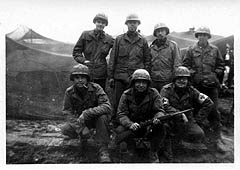
Gebhardt and his hqtrs section (L to R top) Cpl. Healy, Heritage, Haas;
(L to R) St. Amand, Carey, "Doc" Travis.
--Lt. Gebhardt's handwritten notes from photo back
419TH ARMORED FIELD ARTILLERY BATTALION
APO 260, U.S. ARMY
31 December 1944
SUBJECT: After Action Report, 419th Armd FA Bn.TO: Commanding General, 10th Armd Div., APO 260, U.S. Army.
Lt. Col. 419th Armd FA Bn.,
Commanding
S-1 Journal
S-2 Journal
S-3 Journal
419TH ARMORED FIELD ARTILLERY BATTALION
APO 260, U.S. ARMY
1 February 1945
SUBJECT: After Action Report, 419th Armd FA Bn.TO: Commanding General, 10th Armd Div., APO 260, U.S. Army.
Lt. Col. 419th Armd FA Bn.,
Commanding
S-1 Journal
S-2 Journal
S-3 Journal
419TH ARMORED FIELD ARTILLERY BATTALION
APO 260, U.S. ARMY
4 March 1945
Subject: After Action Report, 419th Armd FA Bn.
TO: Commanding General, 10th Armd Div., APO 260, US Army.
Lt. Col. 419th Armd FA Bn.,
Commanding
S-1 Journal
S-2 Journal
S-3 Journal
419TH ARMORED FIELD ARTILLERY BATTALION
APO 260, U.S. ARMY
3 April 1945
Subject: After Action Report, 419th Armd FA Bn.
TO: Commanding General, 10th Armd Div., APO 260, US Army.
Lt. Col. 419th Armd FA Bn.,
Commanding
S-1 Journal
S-2 Journal
S-3 Journal
419TH ARMORED FIELD ARTILLERY BATTALION
APO 260, U.S. ARMY
2 May 1945
Subject: After Action Report, 419th Armd FA Bn.
TO: Commanding General, 10th Armd Div., APO 260, US Army.
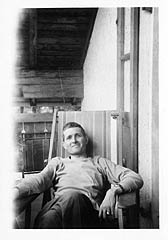
by Tony Vaccaro

click here
by George Wilson

click here
Breakout at Normandy:The 2nd Armored Division in the Land of the Dead
by Mark A. Bando

click here
Bill Mauldin's Army
by Bill Mauldin
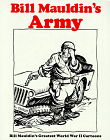
click here

Lt. Gebhardt in Germany
(above and below).
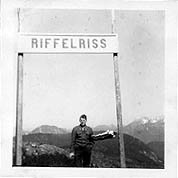


click here
The Hiding Place
by Corrie Ten Boom

click here
Infantry Soldier: Holding the Line at the Battle of the Bulge
by George W. Neill

click here
The Bloody Forest
by Gerold Astor

click here
Acts of War The Behaviour of Men in Battle
by Richard Holmes

click here
Citizen Soldier
by Stephen Ambrose

click here
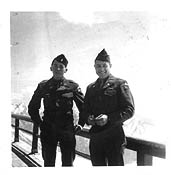
Lt. Gebhardt and Lt. Charles Buck, of Headquarters Battery, in Germany, 1945. Buck was from Hartford, Ct. and, according to Malcolm Cohen, died in 1998.
American Tanks of World War II
by Thomas Berndt, Thomas Berhdt
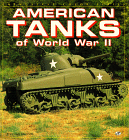
click here
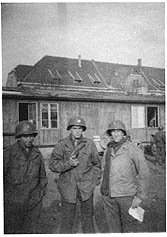
Lt. Gebhardt (left),Capt. Anderson (middle) and Sgt. Carter (right). Metz, France, February 1945.
On Time, On Target
by John D. McKenzie

click here
Americans At War
by Stephen Ambrose

click here

Capt. Anderson (left) and Lts. Cohen (middle) and Gebhardt (right).
US Army Handbook
by George Forty

click here
The German Army Handbook 1939-1945
by James Lucas
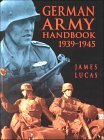
click here
Handbook on German Military Forces
US War Dept., Stephen Ambrose
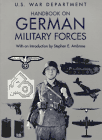
click here
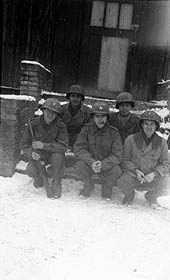
Lt. Gebhardt (left, front), Capt. Anderson (center, front), Lt. Malcolm Cohen (back, right),
and other "A"-Battery Officers.
The Victors: Eisenhower and His Boys: The Men of World War II
by Stephen Ambrose

click here
Patton's Ghost Corps: Cracking the Siegfried Line
by Nathan Prefer, Lathan N. Prefer

click here
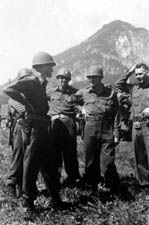
Capt. Anderson (left) and
Gerry St. Amand (right).
"9 May 1945: The Bn participated
in a Division review before the
Corps Commander. Btry A fired the
13 gun salute to the Corps Commander
and 21 gun salute as the American Flag
was raised over the soil of a conquered
nation. It was necessary to use live
ammunition and the high altitude bursts
over the snow covered peaks were timed
perfectly." --Col. McCabe
Knight's Cross : A Life of Field Marshal Erwin Rommel
by David Fraser

click here
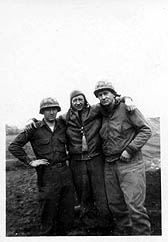
Sgt. J. C. Orange (left), Sgt. Sande
(middle), and Sgt. Regovitch (right).
The Deadly Brotherhood: The American Combat Soldier in World War II
by John C. McManus

click here
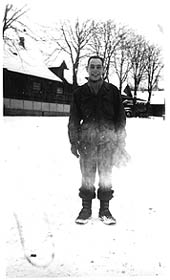
Lt. Malcolm Cohen, winter, 1944-45.
Death Traps : The Survival of an American Armored Division in World War II
by Belton Y. Cooper, Stephen E. Ambrose

click here

Sgt. J. C. Orange playing guitar. I met him at the 419th 1998 reunion. He spoke of a cold, wet night in a French orchard in the fall of 1944. There was gunfire. My dad called him on the wire phone and ordered him to take his unit to investigate. Before venturing out with his men he jokingly responded, "couldn't we wait till they go away?"
American Intelligence and the German Resistance to Hitler
by Jurgen Heideking (Editor), Christof Mauch (Editor)

click here
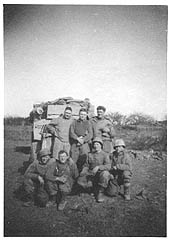
3rd Gun Division in front
of their half-track.
Patton: A Genius for War
by Carlo D'Este

click here
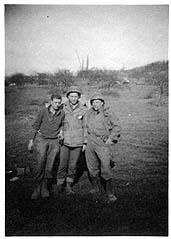
Bosh, Orange, and Hamilton.
Against the Third Reich: Paul Tillich's Wartime Addresses to Nazi Germany
by Paul Tillich, Ronald H. Stone, Matthew Lon Weaver

click here
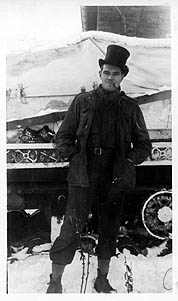
"Dapper Dan" (Ed) Healy
The World Within War: America's Combat Experience in World War II
by Gerald F. Linderman

click here

Capt. Anderson (right) and Lt. Gebhardt (middle, back). According to Malcolm Cohen, if Capt. Anderson wasn't drinking, no one else would've been allowed to, either.
Payoff Artillery-WWII: The Wide Ranging Combat of the Battalion That Fought Under Five Armies and Eight Divisions in the European Theatre
by Gerald F. Linderman

click here
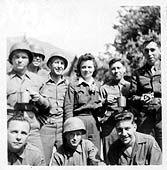
AKC girl & admirers. June 1945, Gormisch-Partenkirchen, Germany. (Lt. Gebhardt, far right).
After the War (Motta Photography Series)
by Werner Bischof (Photographer), Miriam Mafai

click here
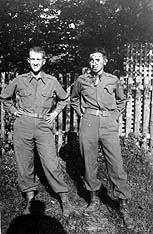
Lt. Carter (left), Lt. Gebhardt (right)
Weilheim, Germany, July 1945.
Small Unit Leadership: A Commonsense Approach
by Dandridge M. Malone

click here
The Greatest Generation
by Tom Brokaw

click here
The Rommel Papers
by Erwin Rommel, et al

click here
A Blood-Dimmed Tide: The Battle of the Bulge by the Men Who Fought It
by Gerald Astor

click here
A Time for Trumpets: The Untold Story of the Battle of the Bulge
by Charles B. MacDonald

click here
The Bitter Woods: The Dramatic Story, Told at All Echelons...
by John S. D. Eisenhower, Stephen E. Ambrose

click here
Hitler's Last Gamble: The Battle of the Bulge, December 1944-January 1945
by Trevor Nevitt Dupuy, David L. Bongard (Contributor), Richard C. Anderson (Contributor)

click here